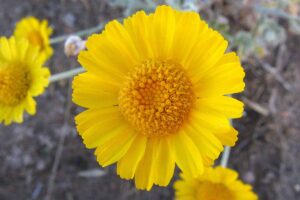Ratibida columnifera
If you’re looking for a drought-tolerant perennial with a slightly quirky vibe, meet your new favorite prairie native – Mexican hat!
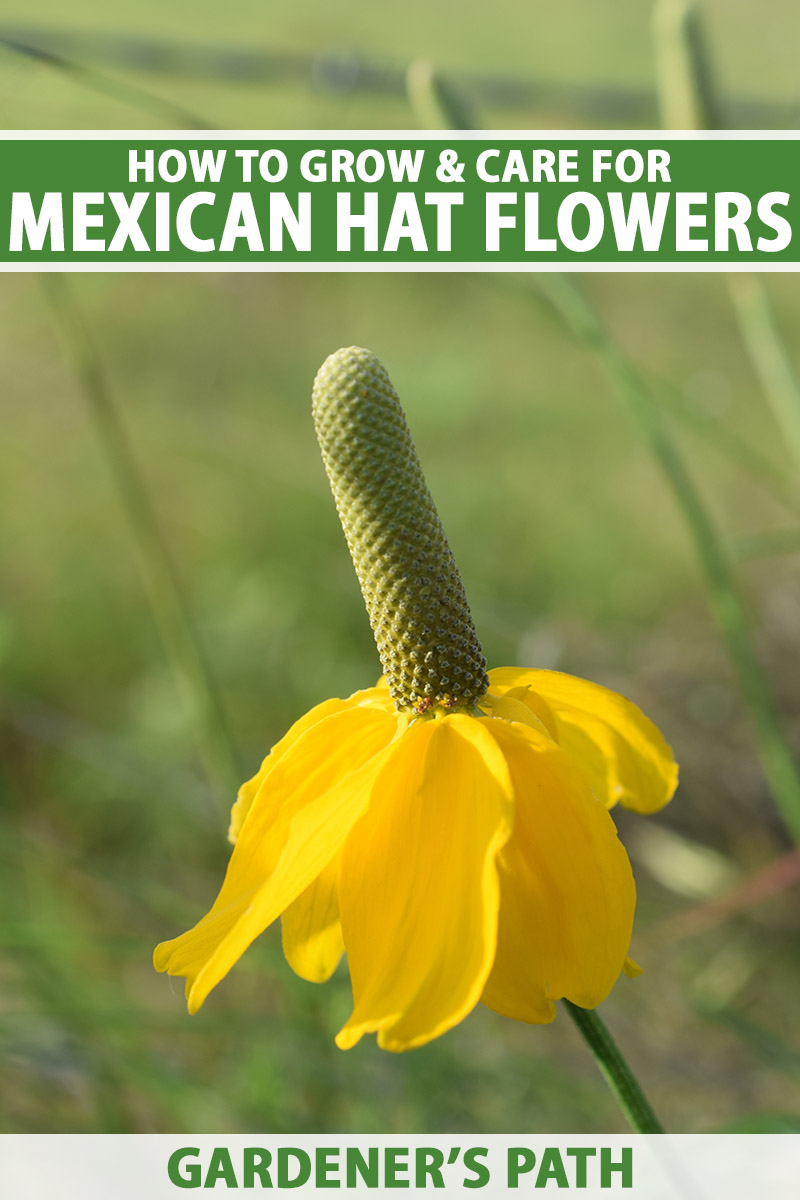
We link to vendors to help you find relevant products. If you buy from one of our links, we may earn a commission.
With its striking and unusual flowers, this North American species brings bright splashes of color to the landscape, but needs little to no upkeep in return.
And it’s a favorite of birds, bees, and butterflies!
Ready to find out if it’s going to be one of your favorites too? We’re going to cover everything you’ll need to know to grow this resilient perennial.
Here’s a sneak peek:
What You’ll Learn
Just to make sure we’re on the same page before we get started, in this article we’re talking about a flowering perennial, and not the succulent Kalanchoe daigremontiana, which is also sometimes called Mexican hat.
What Is Mexican Hat?
Mexican hat, referred to in scientific circles as Ratibida columnifera, is a type of prairie coneflower known for its conspicuous blooms.
The one- to two-inch flowers have droopy yellow, yellow and red, or reddish brown petals.
But it’s the cones of the flowers that are distinctive – they are elongated, rising up to two inches above the petals, creating a sombrero-like shape that gives this wildflower its common name, Mexican hat.
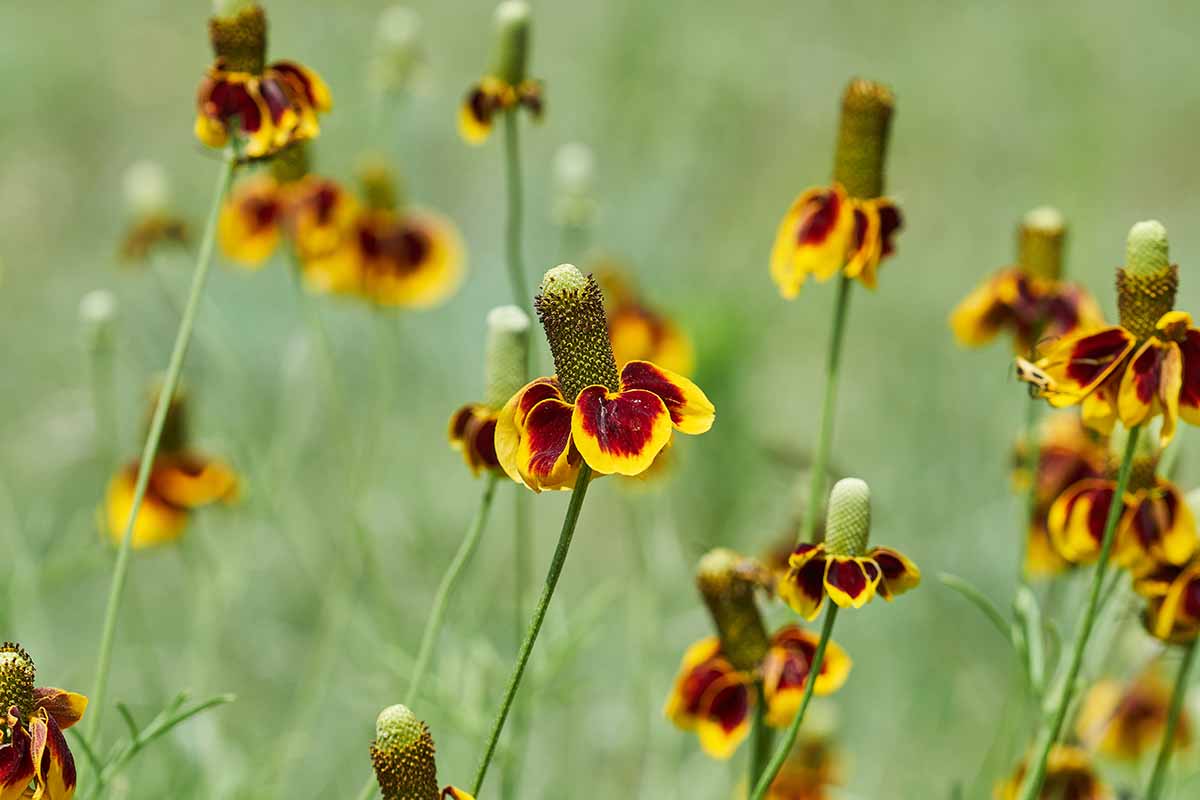
The plant’s unusual blooms are produced over a duration of three to four months, from late spring into autumn, depending on the location.
In fall, the cones turn brown as the seeds ripen.
Flower stalks are tall and leafless, emerging from a mound of wispy green foliage made up of finely divided, alternate leaves.
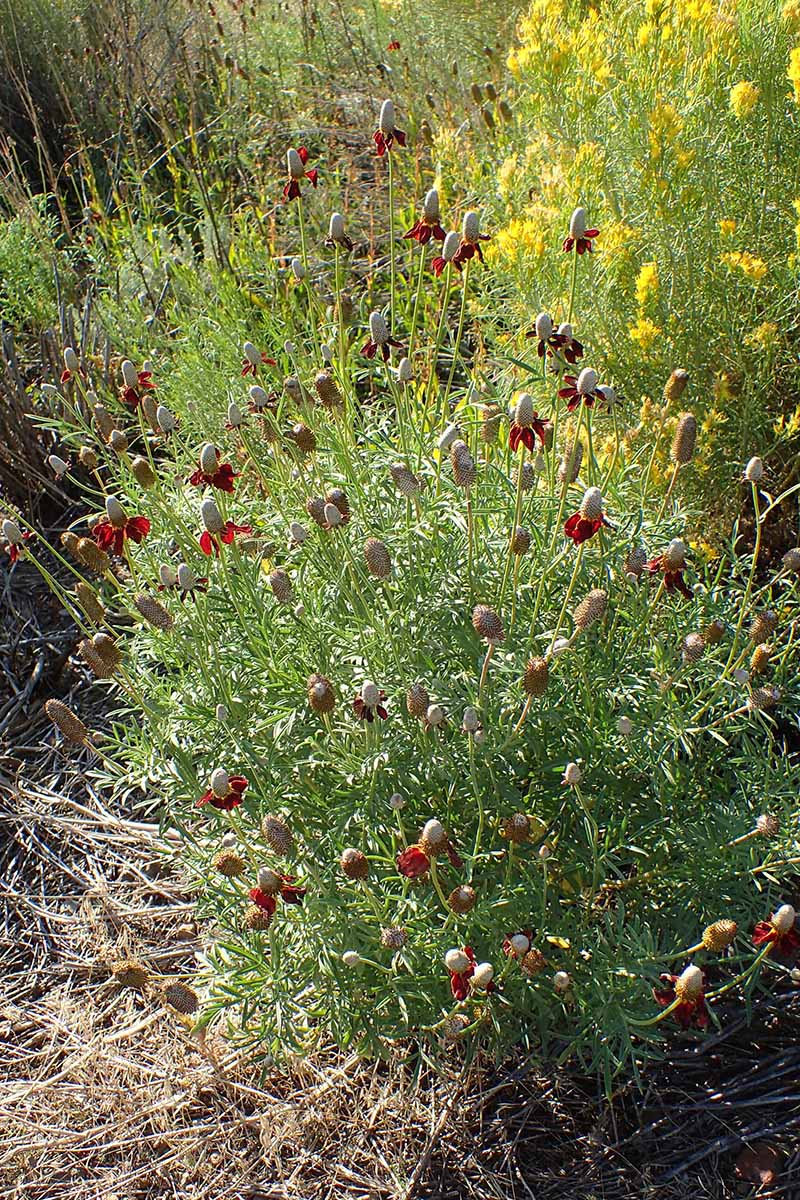
Plants have an upright, clumping form, growing to be one to three feet tall, with a spread of one to two feet wide.
This perennial dies back to the crown at the end of the season and regrows from a woody base each year.
Cultivation and History
Mexican hat is native to the Great Plains of North America, ranging from Canada to Mexico.
In the wild, this species is found in prairie grasslands, mountain foothills, savannas, and plains habitats. It is frequently found growing along roadsides or in pastures.
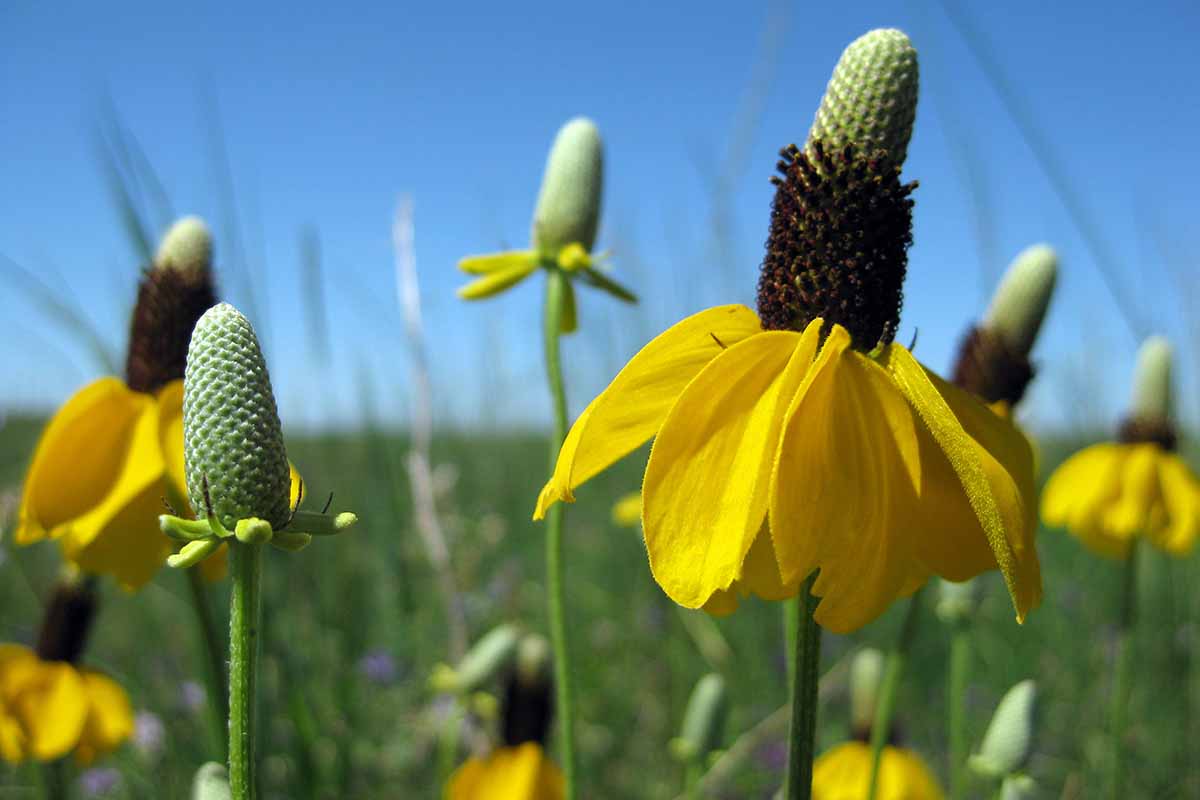
R. columnifera is a member of the Asteraceae family, related to other North American natives such as echinacea and joe-pye weed, and to other common garden flowers such as marigolds and cosmos.
The Ratibida genus, also known as the “prairie coneflowers,” is made up of just seven species. It includes the naked prairie coneflower (R. peduncularis) and the pinnate prairie coneflower (R. pinnata) in addition to R. columnifera.
This wildflower is also known as the upright prairie coneflower, long-headed coneflower, columnar prairie coneflower, and thimbleflower.
This plant has an ethnobotanical history of medicinal use in North America. The Cheyenne used it as an antidote for rattlesnake bites and to relieve other ailments, such as poison ivy rashes.
Propagation
The best way to propagate upright prairie coneflower is from seed, which you can do either through direct sowing or by starting seedlings in pots.
Before you plant, it’s a good idea to plan your landscape design in a notebook or gardening journal. These plants should be spaced one and a half to two feet apart.
Let’s look at the steps needed to propagate this native species, as well as how to transplant potted seedlings.
Direct Sowing
Mexican hat seeds can be sown either in early spring or in fall.
Either way, be aware that the seeds need to undergo cold, moist stratification to germinate.
For fall plantings, seeds will rest dormant over winter in the cold, germinating only in the spring. This process is the same as what’s used when pre-seeding a flower garden.
If you choose to wait to sow until spring, place seeds in moist sand in the fridge for four weeks before sowing to provide the cold moist stratification needed.
To direct sow in spring, make sure to schedule this project for early in the season, when the soil has started to warm but temperatures are still cool.

When ready to sow, clear your planting area of weeds, then scrape some of the soil back with the edge of a hori hori or garden trowel.
Press seeds into the soil, planting extras to make up for low germination rates, then cover lightly so they are buried a quarter to half an inch deep.
Keep the germinating seeds lightly moist. They may take up to four weeks to germinate.
When seedlings have two to three sets of true leaves, thin them so they are spaced one and a half to two feet apart.
Water regularly until the seedlings are established, removing any weeds that pop up around them.
Starting Seedlings in Pots
If sowing into pots, sow several seeds each into three-inch pots containing a sterile growing medium.
For a biodegradable nursery pot option, I recommend CowPots, which will make the transplanting process more gentle.

12-Pack of 3-Inch Biodegradable CowPots
You can purchase a twelve-pack of three-inch biodegradable pots from the CowPot Store, via Amazon.
Cover seeds lightly with soil, then place the pots in a cold frame preferably, and water to keep lightly moist.
Thin seedlings to one per pot once they have two to three sets of leaves.
When plants have several leaves, they are ready to transplant.
For specimens started indoors, harden them off first by setting them outside for increasingly long periods of time over the course of a few days.
From Transplants
When transplanting upright prairie coneflower, you will either be starting with a young plant that you started from seed yourself, or one that you purchased from a nursery.
Either way, if the plant started its life in a protected location such as a greenhouse or cold frame, harden it off before transplanting.
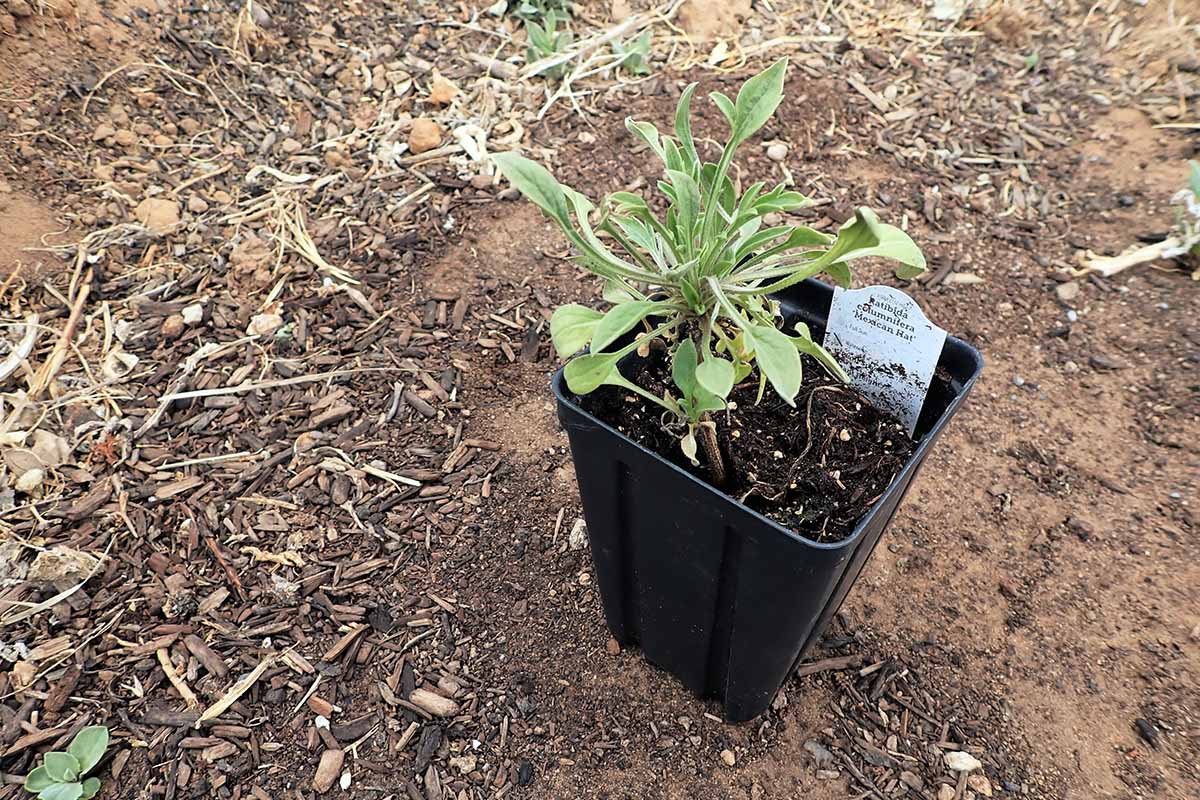
Once you’re ready to transplant, dig a hole that is twice as wide as the nursery pot, but just an inch or two deeper.
For specimens grown in plastic nursery pots, remove the plant from its pot, then rub your hand against the root ball to loosen up the roots.
If any of the soil is released from the nursery pot, mix it with the soil you removed from the hole. Add a handful of natural, all-purpose fertilizer to the soil as well.
For transplants started in biodegradable pots, break off the rim of the pot that sticks up above the growing medium.
Add some of the soil and fertilizer back into the hole, then situate the plant in the hole.
In arid climates, it can be helpful to plant the crown of the plant slightly deeper than the surface of the surrounding soil, so that a “saucer” is formed around the plant, which will help catch and retain water.
In non-arid climates, make sure the crown is level with rather than deeper than the soil surface to prevent root rot.
Once the transplant is situated at the right level, backfill with soil, tamp gently, and water in.
Water newly planted Mexican hat specimens regularly when rainfall is scarce until they get established.
How to Grow
A native of primarily wide, open spaces, upright prairie coneflower should be grown in full sun.
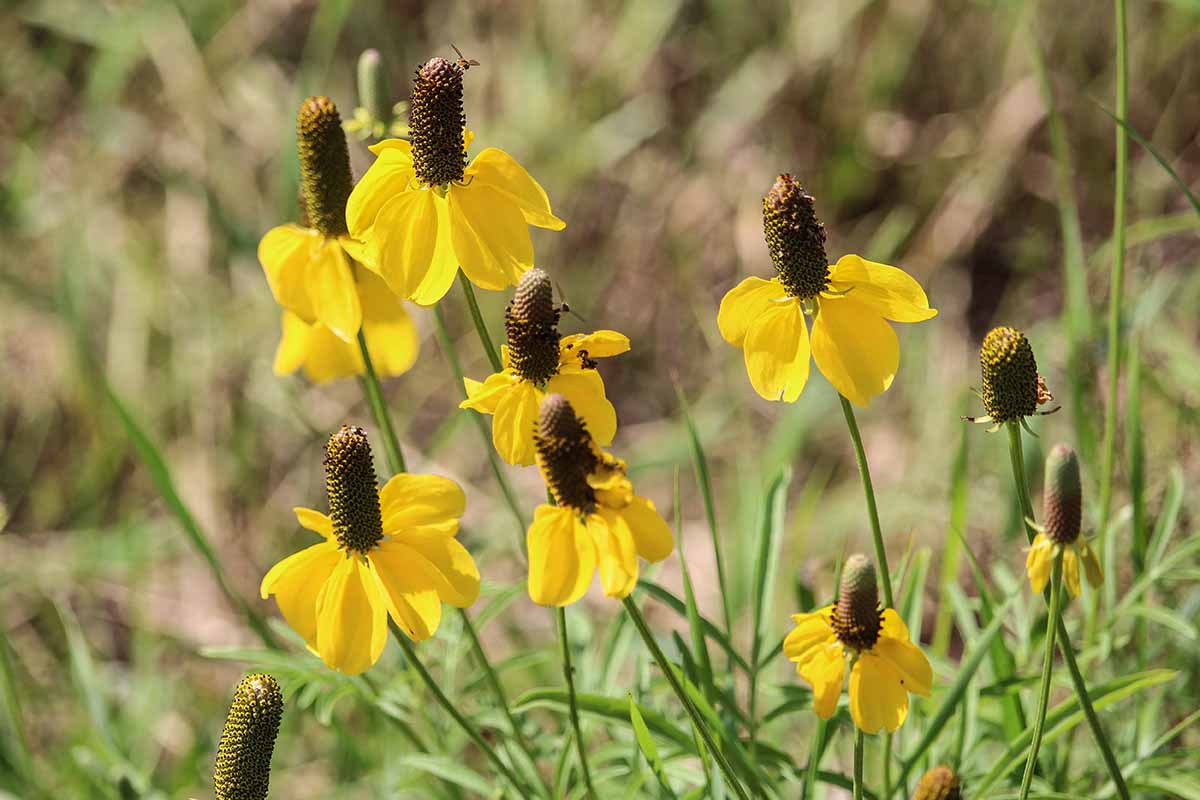
This species will also tolerate some light afternoon shade.
With a fairly widespread native range, Mexican hat’s soil preferences are fairly flexible.
The soil should be well draining, but apart from that, upright prairie coneflower can adapt to soils which are sandy, sandy loam, loam, clayey loam, or gravelly. In the wild, this species is often found growing near deposits of limestone.
Generally, it thrives in soils that are low in organic matter, and will be shorter-lived in rich soil.
As for pH, R. columnifera tolerates a soil pH range between 6.8 and 7.2, or in other words, from slightly acidic to slightly alkaline.
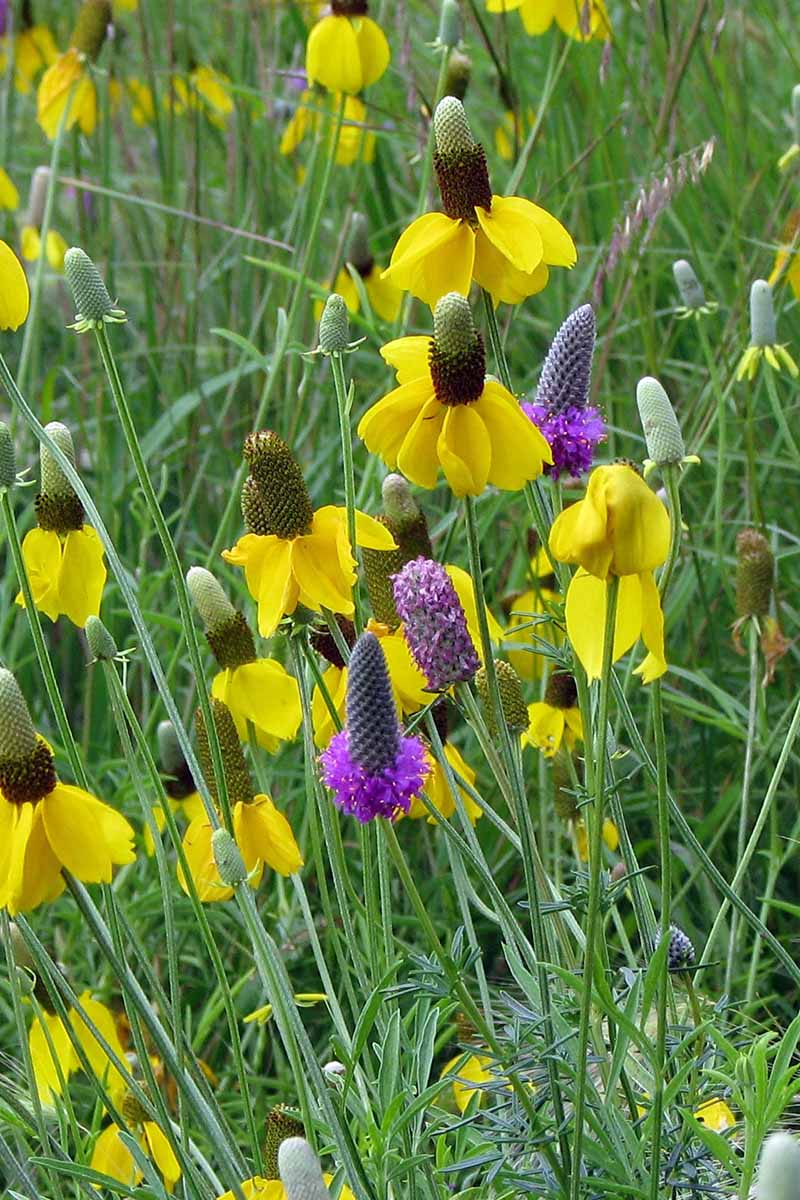
Adapted to dry locations, upright prairie coneflower thrives with low to moderate water, requiring between 10 and 30 inches of water per year.
In arid locations with little rainfall or during periods of drought, irrigate new plantings until they are established. Depending on local precipitation, additional watering may be needed during the summer months.
Avoid overwatering, which can lead to fungal problems.
Growing Tips
- Plant in full sun.
- Grow in well-draining soil.
- Provide additional irrigation if needed in arid climates or drought conditions.
Pruning and Maintenance
As a self-sufficient wildflower, and especially when grown within its native range, Mexican hat won’t require much in the way of maintenance.
However, for those who don’t mind putting in the extra effort, there are a few seasonal chores that will keep this native species in tip-top shape.
In springtime, mature plants can be pruned down to one to two inches tall to trim back faded foliage.
Throughout summer, flowers can be deadheaded, if desired, to extend the plant’s blooming period.
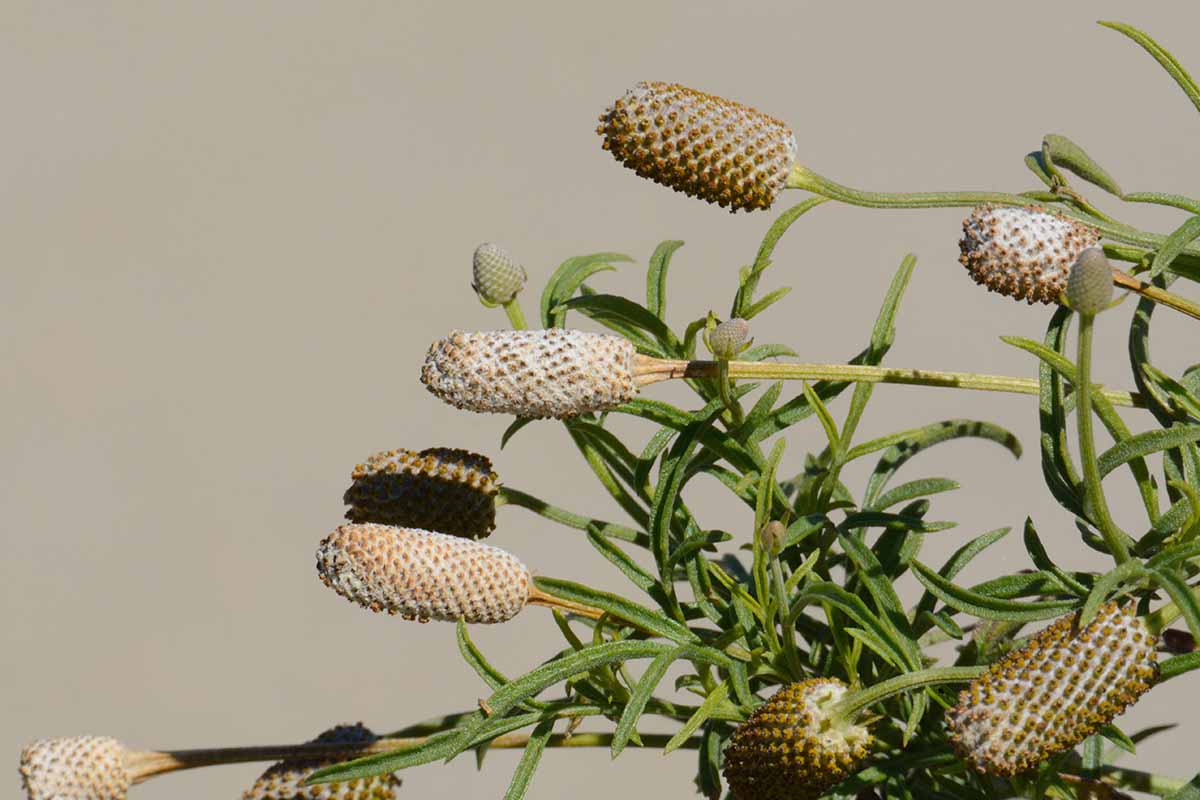
However, be sure to leave some spent flowers in place at the end of the growing season so the birds can enjoy the seeds.
Upright prairie coneflower can re-seed, and in some circumstances they may be slightly aggressive. To contain this wildflower, go ahead and remove the seed heads.
In fall, fertilize with an all-purpose natural fertilizer well adapted for prairie plants.
My preferred choice for this purpose is Yum Yum mix, a 2-1-1 (NPK) organic and natural plant food made with a variety of ingredients including alfalfa and kelp meal, molasses, and humates.

Yum Yum Mix is available in 12-pound bags from Soil Mender, via Amazon.
Follow the manufacturer’s instructions for applying this product.
Varieties and Cultivars to Select
There are a few different naturally occurring varieties of this species available for purchase.
If you wish to add these to your landscape, look for transplants at local native plant sales, or seek out vendors that specialize in natives for seed.
Reddish Brown
This selection is also called ‘Dwarf Red Coneflower,’ and is sometimes classified as R. columnifera var. pulcherrima.
A compact variety, it reaches 18 inches tall and bears deeply hued, reddish brown petals faintly outlined with gold.

‘Dwarf Red Coneflower’ is available for purchase in packs of 2000 seeds from Isla’s Garden Seeds via Amazon.
Yellow
Reaching 30 inches tall, this selection produces masses of flowers with cheery yellow petals.

You’ll find yellow long-headed coneflower for purchase in a selection of pack sizes ranging from 2,000 seeds to one pound of seeds from Everwilde Farms via Amazon.
Yellow and Red
Finally, this bicolored variety of Mexican hat has yellow and red petals, and reaches 24 inches in height.

Want to try this fiery selection? Yellow-and-red-flowered Mexican hat seeds can be purchased in an array of package sizes from Everwilde Farms via Amazon.
Managing Pests and Disease
Upright prairie coneflower is resistant to deer and is not plagued by any major pest problems.
However, diseases can take hold in some circumstances, primarily when grown in more humid conditions, making plants susceptible to crown rot, powdery mildew, or root rot.
Even when fungal issues occur, plants don’t usually succumb to these diseases.
However, these can be prevented by respecting the proper plant spacing and growing the species in well-adapted regions.
Best Uses
Mexican hat is a wildflower that’s well-adapted to many uses. It makes a welcome addition to the cut flower garden, and can also be grown in containers.
In the garden it can be counted among insectary plantings and used to provide forage for pollinators such as butterflies.
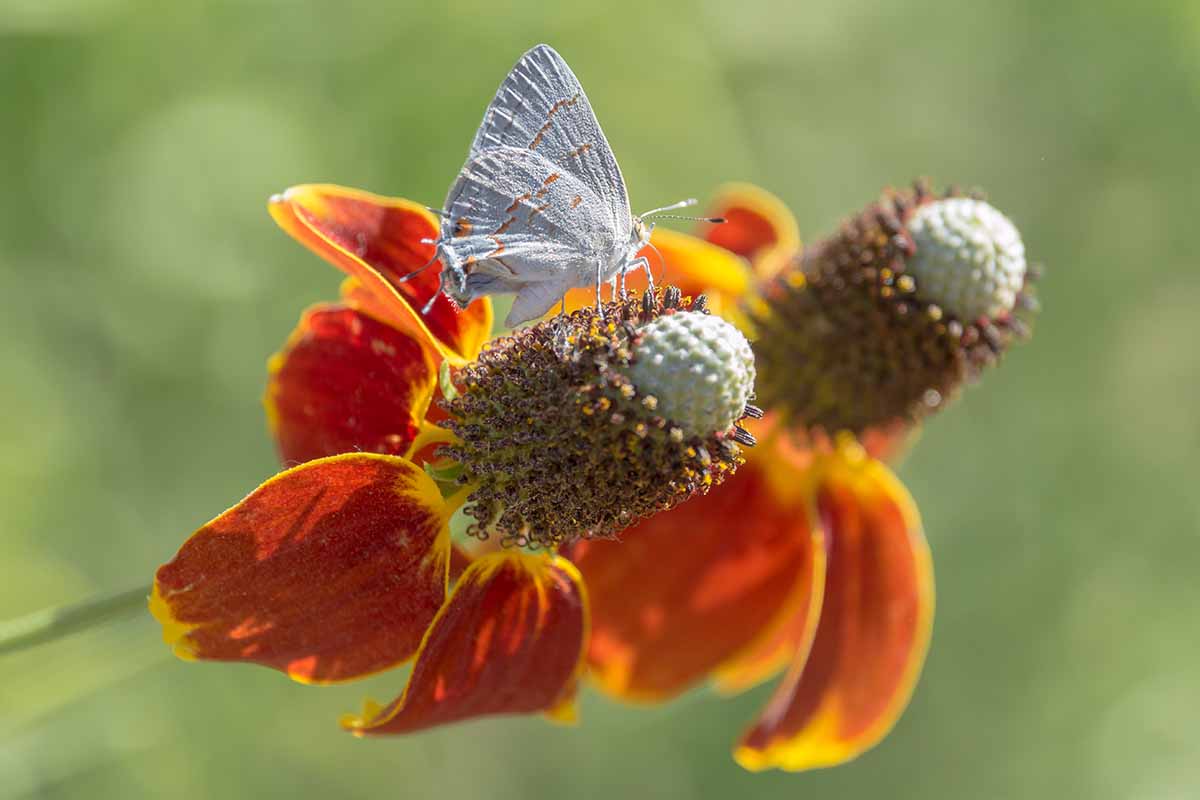
Bees also love upright prairie coneflower, and this species is especially helpful in providing food for native bee populations.
Birds also love to visit dried upright prairie coneflower seed heads as a source of food in fall and winter.
For larger-scale landscaping projects, R. columnifera can be mass planted to create a swath of warm color. It can be allowed to naturalize, grown in meadows, or otherwise used for conservation.

Upright prairie coneflower can be grown on slopes and used to help prevent erosion, or it can be allowed to spread along fences and walls.
And since this species is drought tolerant, it can be incorporated into a xeriscape design, or it can be grown along roadsides where irrigation is limited.
Quick Reference Growing Guide
| Plant Type: | Herbaceous flowering perennial forb | Flower / Foliage Color: | Yellow, yellow and red, reddish-brown /green |
| Native to: | North America | Tolerance: | Deer, drought, poor soil, slopes |
| Hardiness (USDA Zone): | 4-9a | Maintenance | Low |
| Bloom Time: | May-October | Soil Type: | Sandy, sandy loam, loam, clayey loam, gravel |
| Exposure: | Full sun | Soil pH: | 6.8-7.2 |
| Time to Maturity: | 2 years | Soil Drainage: | Well-draining |
| Spacing: | 1.5-2 feet | Attracts: | Bees, birds, butterflies, other pollinators |
| Planting Depth: | 1/4 -1/2 inch (seeds), top of root ball even with soil line (transplants) | Companion Planting: | Big sagebrush, common yarrow, gaillardia, prairie junegrass, purple prairie clover |
| Height: | 12-36 inches | Uses: | Butterfly gardens, containers, cut flowers, insectaries, meadows, mass plantings, naturalizing, roadsides, slopes, wildlife gardens, xeriscaping |
| Spread: | 18-24 inches | Order: | Asterales |
| Growth Rate: | Moderate | Family: | Asteraceae |
| Water Needs: | Low to moderate | Genus: | Ratibida |
| Common Pests and Diseases: | Tortricid moths; crown rot, powdery mildew, root rot | Species: | Columnifera |
An Upstanding Floral Option
As an excellent native wildflower, let’s tip our hats to upright prairie coneflower!
This perennial will grace landscapes with its unique flowers and help to sustain native wildlife, while providing gardeners a reprieve from chores.
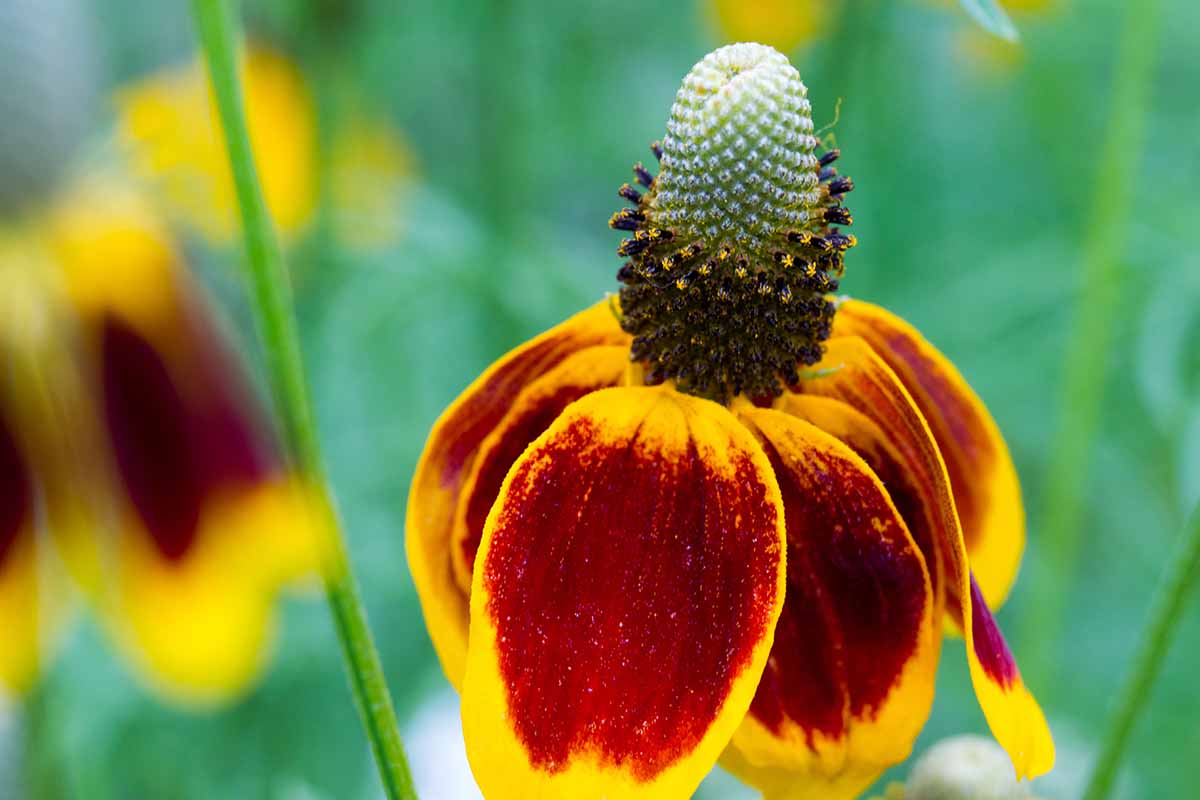
How do you plan to use Mexican hat in your own landscape? Let us know in the comments section below – and feel free to show off photos of your good work!
And if you’re looking for additional wildflowers for your landscape, keep reading right here:
